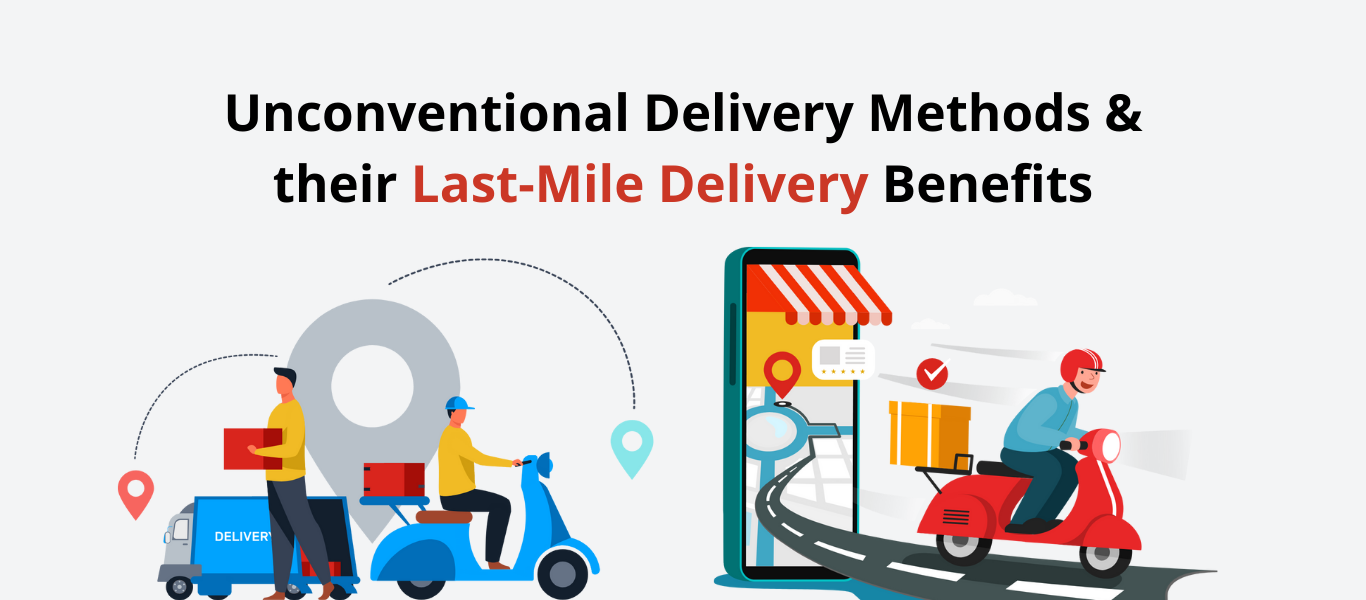Unconventional Delivery Methods And Their Last-Mile Delivery Benefits

As package quantities increase, corporations may turn to unconventional delivery methods like bikes, skateboards, and drones in the future years to reduce last-mile expenses and improve sustainability.
The high costs of last-mile delivery (more than half of the total delivery costs) are due to the loss of cost-cutting methods used in the preceding miles. Without the efficiency and economies of scale provided by consolidated shipping, bulk shipments are broken into thousands of individual deliveries, each with its service level, end location, contact information, and other details.
Although technology such as route optimization has made significant progress in helping delivery fleets to tackle this problem, trucks, and vans are no longer the only participants in the last-mile game worth mentioning. Companies are increasingly seeking alternate and unorthodox modes of package delivery to keep costs down and service levels up as e-commerce propel package deliveries toward a market worth of $666 billion by 2030.
Bikes And Skateboards: Maximising urban mobility for quick delivery-
Personal mobility equipment such as bicycles, roller skates, and even skateboards are gaining popularity as a means of assisting couriers and delivery employees in navigating urban environments.
Aside from their lower prices, these gadgets outperform trucks and vans in various aspects, the first of which is onboarding. The requirement for a driver’s licence, valid registration, and road experience is removed, making it easier to find delivery employees. Another key benefit is mobility, which is the whole purpose of these devices: a courier on a bike or skateboard may travel where a driver cannot and use pedestrian paths to avoid congested roads. In urban delivery, GPS tracking has revealed that bikes can be 1.6 times faster than vans.
Switching away from conventional delivery vehicles has significant environmental and ecological benefits. For example, an e-cargo bike is predicted to generate at least eight times fewer emissions per kilometer than a diesel van, while also assisting in the reduction of urban congestion created by delivery vehicles hunting for parking. With its Eco Courier service, Indonesia’s Westbike Messenger has set a good example by providing same-day delivery in Jakarta utilising bicycles that do not require engines or gasoline.
Drones and robot couriers are the next steps in delivery automation :
High-tech delivery automation in aerial drones and ground-based courier robots of various types has a bright future. Drones already account for more than 61 percent of the autonomous last-mile delivery business, which is predicted to increase at a 19 percent CAGR over the next decade.
Drones have already been used to carry e-commerce purchases, food, and even medical supplies around the world in recent years. The costs of a traditional ground-based fleet would be eliminated by using a fleet of these unmanned aerial vehicles to transfer items from hubs to adjacent addresses. When integrated with consumer-facing app-driven track-and-trace features, this would enable a delivery pace that reduces failed attempts and maximises pleasure. With time, current trucks might be used as mobile launch bays to integrate drones into last-mile operations, extending on-demand drone coverage and assisting drivers in maintaining SLAs in hard-to-reach locations.
Autonomous courier robots, whether wheeled, bipedal or otherwise, provide a viable alternative to trucks and vans. Aside from saving money on experienced drivers, these machines can work around the clock, just like their aerial drone counterparts, responding to requests at any time of day and even waiting for clients if necessary. Drones and delivery robots are both substantially greener than conventional cars because they are driven by electricity. Drones, for example, generate up to 54 percent fewer pollutants than trucks on short-distance runs, according to studies.
Both of these machines are expected to work together in the future to automate the last mile. According to studies, robots might transport more than 20 billion items per year over the next decade, producing $50 billion in revenue. With these advancements and the rise of personal mobility devices as a viable option for delivering consumers in dense or infrastructure-deficient urban environments, delivery fleets have a variety of possibilities for future expansion.
As you can see, a reliable last-mile delivery system may significantly improve your productivity and delivery experience. LogixPlatform has been enabling retailers all around the world to improve their last mile operations and increase delivery efficiency. Sign up for a brief demo to see how we can improve your last-mile.

